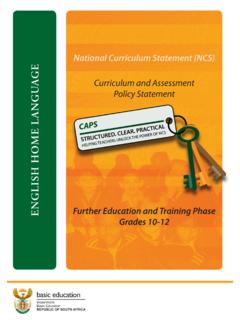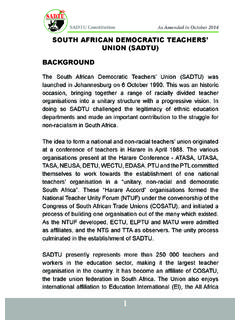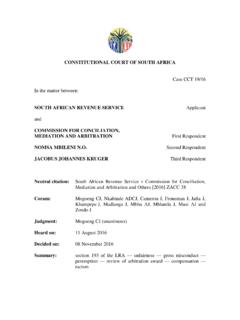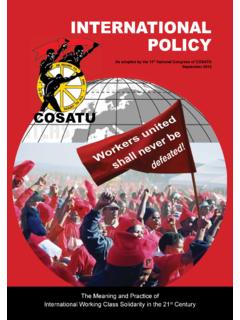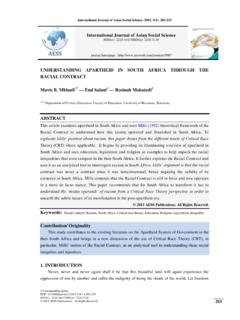Transcription of THE IMPOSSIBLE CONCEPT: SETTLER LIBERALISM, …
1 1universityof south africaAfrican Historical ReviewVolume 47 | Number 2 | 2015pp. 1 36 DOI: Print ISSN 1753-2523 | Online 1753-2531 Unisa Press THE IMPOSSIBLE CONCEPT: SETTLER LIBERALISM, PAN-AFRICANISM, AND THE LANGUAGE OF NON-RACIALISM*Jon SoskeDepartment of History and Classical StudiesMcGill University and Centre for Indian Studies in Africa University of the article traces the history of four words: non-racial , non-racialism , multi-racial , and multi-racialism . Its main concern is to identify when and how these terms developed a role within British colonial and South African political discourse.
2 At the end of the 1950s, the struggles within the anti- apartheid movement became entangled with a broader discussion across southern and eastern Africa regarding democracy, nationalism, and political representation. In clarifying the significance of this moment, this article reconstructs the earlier history of multi-racial democracy from its formulation in South African liberal circles in the 1930s to its incorporation into British colonial policy following the Second World War. It then traces the divergent conceptualisations of non-racialism and African nationalism that developed in response to multi-racial democracy.
3 It concludes that African National Congress (ANC) leaders adopted the language of non-racial democracy in a reactive fashion after the 1958 Africanist split in order to clarify the organisation s position on group : non-racialism, multi-racialism, Pan Africanist Congress, African National Congress, Tom Mboya, Albert Luthuli, Robert Sobukwe, Liberalism This article traces the history of four words: non-racial , non-racialism , multi-racial, and multi-racialism . Its main concern is to identify when and how these terms developed a role within British colonial and South African political discourse.
4 At what point do these terms acquire a regular usage associated with a set of standardised arguments and correlated or opposing terms? This exercise does not presuppose that the words non- Downloaded by [McGill University Library] at 16:41 19 May 2016 2 SoskeThe IMPOSSIBLE conceptand multi-racial with or without the ism refer to stable concepts. Not only did their meanings change over time, but at certain key moments no consensus existed regarding their usage. Like many politically significant terms, they acquired their importance because they were central to an ongoing and historically shifting dispute over a set of questions that refused simple or definitive resolutions.
5 The idea of non-racialism has long been, to borrow a phrase from the philosopher Gallie, an essentially contested term .1 In large part, the contestations surrounding the terms multi-racialism and non-racialism reflect their semantic dependency on the sign race .2 Not only do ideas and practices of race possess their own complex, stratified, and disputed histories, race is an inherently unstable concept. As a discourse that both organises and naturalises inequality, racial ideology functions through the confusion of the biological and the social and therefore resists systematic definition (and thus refutation) in either The production of racial difference operates at the scale of political economy and in everyday gestures.
6 It functions through state violence and in embodied experiences. It is statistically measurable and profoundly subjective. Race is both a structure of domination and a rich terrain of contest where identities and cultural practices are produced, deployed, nurtured, and disavowed. Because of its articulation with categories like gender and class, racism often functions through liberal discourses and institutions that are explicitly race neutral such as the law or To a considerable degree, the very language of race invites confusion: it suggests a false equivalency between whiteness and blackness as social formations.
7 Constituted through a differential relationship to the violence of SETTLER civil society, these categories are less discrete identities than interdependent, and fundamentally antagonistic, ontological Moreover, the concepts that social scientists frequently use to critique racism, like ethnicity and culture, are embedded 1 Gallie, Essentially Contested Concepts , Proceedings of the Aristotelian Society 56, (1955 1956), McDonald makes a similar observation, but then attempts to resolve this instability through an analysis of the distinction between racism and racialism. Although theoretically sound, the distinction is difficult to maintain in practice for reasons discussed below.
8 See M. MacDonald, Why Race Matters in South Africa (Boston, Harvard University Press, 2006), 93. For a fuller discussion of the language of race in the context of non-racialism and the anti- apartheid struggle, see G. Mar , Non-racialism in the Struggle against apartheid , Society in Transition, 34,1 (2003), See Fields, Race, Slavery and Ideology in the United States of America , New Left Review, 181 (May-June 1990), 95-118. 4 See S. Hall, Race, Articulation and Societies Structured in Dominance , in Sociological Theories: Race and Colonialism (Paris, UNESCO, 1980), 342; J. Sexton, Amalgamation Schemes: Antiblackness and the Critique of Multiracialism (Minneapolis, University of Minnesota Press, 2008).
9 5 F. Wilderson III, Red, White & Black: Cinema and the Structure of US Antagonisms (Durham, Duke University Press, 2010). The asymmetric character of whiteness and blackness has significant implications for non-racialism. See F. Barchiesi, The Problem with We : Affiliation, Political Economy, and the Counterhistory of Nonracialism in S. Walsh and J. Soske, eds, Ties that Bind: Race and the Politics of Friendship in South Africa (Johannesburg, Wits University Press, forthcoming).Downloaded by [McGill University Library] at 16:41 19 May 2016 3 SoskeThe IMPOSSIBLE conceptwithin the history of racial thought and often serve as racial Stuart Hall famously described race as a floating signifier.
10 7 This instability haunts the ideas of multi- and we understand non-racialism as an ethos, as the rejection of white supremacy, Julie Fredrickse is undoubtedly correct in her classic description. Non-racialism is an unbreakable thread in South African In this particular sense, non-racialism has many origins and forms: it arose from ideological commitments and social milieus; it was embodied in organisational structures and diffuse mentalities; it animated collective political projects and remained deeply personal. At various moments, individuals and groups expressed their desire for a world without racial oppression in the language of Marxism, liberalism, feminism, Christianity, Islam, and African nationalism, to name only some more prominent idioms.








